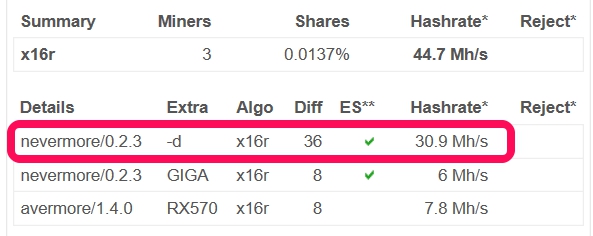

In the X16R white paper, we found a interesting chart which shows the relative running time per sub hashing algorithms. So we spend a bit of time to look for the reason behind of it. Especially, it is found that the hash rate fluctuates in short time. That is GPU could not explore its hash rate totally when mining coins using this algorithm. However, we still found there is a small issue inherited in X16R algorithm. Also the re-ordering of the algorithms can easily be changed for each coin in order to keep purpose-built hardware manufacturer from entering ecosystem easily, which in turn keeps miners participating in the mining activity actively, as well as hashing power distributed.Īs one of successful anti-ASIC POW algorithm, X16R are employed by many coins.

the reordering also prevents a simple extension of the current X11 ASICs or future X15 ASICs", quoted from the X16R white paper.īecause not depending on memory intensive hashing algorithm, it is easy for miners to mine coins employing X16R with their idle computers. "This reordering doesn’t make an ASIC impossible to build, but it does require that the ASIC adapts to additional input, which is more easily accomplished by a CPU or GPU. In fact, it’s common to reduce the memory clock frequency to reduce power and heat in this case.As we all know, instead of using memory intensive hashing algorithm, like Scrypt, Equihash and Ethash, to minimize the impact of ASIC miner, X16R employs another strategy : randomly reorder a sequential hashing algorithms based on the last 8 bytes in the previous block hash value. Unlike with Ethereum and Monero, the method of ASIC resistance used by Ravencoin is not as intense on a GPU’s memory, and so miners will instead usually prefer to implement core clock frequency increases instead. However, because blocks’ hash values are fairly random, then over a long period of time, average hash rates still remain a meaningful indicator, as all X16R’s hash functions are equally as likely to occur. The variance of hash rate per block has proven vexatious to some in the mining community, as it impedes conventional benchmarking methods, as well as short-term calculations of mining value. The hash rate is governed by the overall complexity of the mix of included hash functions for that block.
Mining hash calculator x16r 64 bits#
The final 64 bits is split into sixteen 4-bit values, that describe, in order, which of the 16 hash functions defined in X16R are to be used.Īs well as this making X16R much more challenging to implement in an ASIC, it also means that, depending on which of the hash functions are included in a particular block, a given GPU’s hash rate, for that block, will be different than it was for other blocks. The way this works is that the end of the previous block’s hash value determines the current block’s sequence of hash functions. X16R seeks to be problematic to implement in an ASIC by causing which of the 16 hash functions are used, and in what order they are used, to vary with each new block on Ravencoin’s blockchain. X11 was, in due course, implemented in an ASIC, removing its relevance to CPU or GPU mining. Similar to the X11 algorithm from which it is descended, which ran 11 hash functions in series, X16R runs 16 hash functions in series. The algorithm X16R is notable for bringing a different approach than the previously-mentioned algorithms, to ASIC resistance. The most well-known coin to implement X16R is Ravencoin (RVN), for which this algorithm was initially created, though the algorithm is a descendent of X11, initially created for use with Dash (DASH).Ĭompared to Ethereum and Monero, the prominence of Ravencoin in the mainstream mining world is relatively new.


 0 kommentar(er)
0 kommentar(er)
